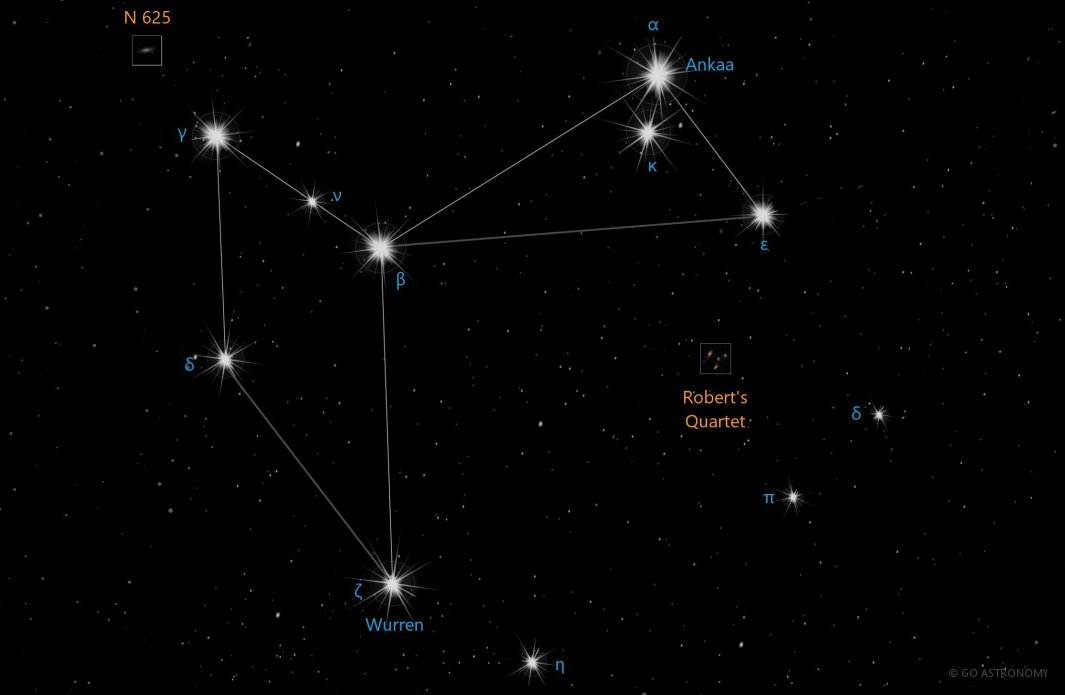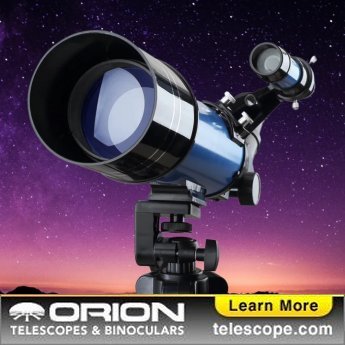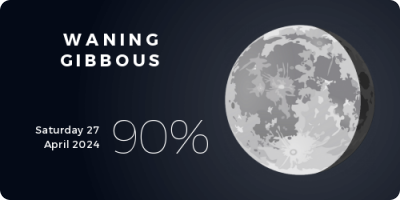Phoenix, the Phoenix (Phe)
(FEE-nix)
The Southern constellation of Phoenix, the Phoenix, is best viewed in Fall during the month of November.
Phoenix is the 37th largest constellation. It's brightest star is Ankaa at magnitude 2.40. The boundary of the Phoenix constellation contains 11 stars that host known exoplanets.
- Pronunciation:
- FEE-nix
- Meaning:
- Phoenix
- Genitive:
- Phoenicis
- Abbreviation:
- Phe
- Constellation Family:
- Bayer
- Hemisphere:
- Southern
- Quadrant:
- SQ1
- Visibility:
- 32° N - 80° S
- Best viewing month*:
- November
- Area:
- 469 sq. degrees
- Size:
- 37th largest
- Right Ascension (avg):
- 0h 44m
- Declination (avg):
- -47°
- Meteor showers:
- Phoenicids
- Brightest star:
- Ankaa (2.40)
- Stars with planets:
- 11
- Messier objects:
- |
- Caldwell objects:
- |
Brightest Stars in Phoenix
The 10 brightest stars in the constellation Phoenix by magnitude.
- Star
- Magnitude
- Spectral class
- Alpha Phoenicis (α Phe)
- 2.4
- K0III
- Beta Phoenicis (β Phe)
- 3.32
- G8IIIvar
- Gamma Phoenicis (γ Phe)
- 3.41
- K5II-III
- Epsilon Phoenicis (ε Phe)
- 3.88
- K0III
- Kappa Phoenicis (κ Phe)
- 3.93
- A7V
- Delta Phoenicis (δ Phe)
- 3.93
- K0III-IV
- Zeta Phoenicis (ζ Phe)
- 3.94
- B6V + B0V
- Eta Phoenicis (η Phe)
- 4.36
- A0IV
- Psi Phoenicis (ψ Phe)
- 4.39
- M4III SB
- Mu Phoenicis (μ Phe)
- 4.59
- G8III
Galaxies in Phoenix
The most notable galaxies in the constellation Phoenix. Also see all galaxies.
- Name
- Alt name
- Type
- Phoenix Dwarf
- dwarf
- IC 5325
- spiral
- IC 5328
- elliptical
- NGC 625
- spiral
- NGC 7744
- elliptical
- NGC 7796
- elliptical
- Robert's Quartet
- galaxy group
Milky Way Satellites in Phoenix
Dwarf satellite galaxies that orbit the Milky Way Galaxy located in the constellation Phoenix. Also see all Milky Way satellite galaxies.
- Galaxy name
- Alt name
- Magnitude
- Phoenix II
Black Holes in Phoenix
These are the most well-known smaller (non-supermassive) black holes in the constellation Phoenix. Although black holes cannot be seen directly, the smaller ones are at the center of some star clusters and supernova remnant nebulae, which can be seen. Supermassive black holes are at the center of most galaxies, such as Sagittarius A* at the center of our Milky Way galaxy. Also see all black holes.
- Black hole
- Type
- HLX-1
- intermediate
The Celestial Firebird
The constellation Phoenix, often associated with the mythical bird that is reborn from its ashes, is a distinctive feature of the southern hemisphere's sky. It is one of the lesser-known constellations, yet it has a rich history and houses various interesting celestial objects, making it a fascinating subject for astronomers and stargazers.
Historical Overview
Phoenix is a relatively modern constellation, introduced in the late 16th century by the Dutch astronomer Petrus Plancius. The constellation was later included in Johann Bayer's Uranometria, one of the most important celestial atlases of the 17th century. Phoenix belongs to the 88 modern constellations recognized by the International Astronomical Union (IAU).
Location and Main Features
Phoenix is located in the first quadrant of the Southern Hemisphere (SQ1), and it can be seen at latitudes between +32? and -80?. It's bordered by several constellations, including Eridanus to the north, Grus to the west, Tucana to the south, and Sculptor to the east. Covering an area of 469 square degrees, Phoenix is the 37th largest constellation in the night sky.
Main Stars in Phoenix
The brightest star in the constellation is Alpha Phoenicis, also known as Ankaa, which is a spectral class K0.5 IIIb orange giant. With an apparent magnitude of 2.37, Ankaa is easily visible to the naked eye under the right conditions. Beta Phoenicis, the second brightest star, is a binary star system that can be split with a small telescope.
Deep Sky Objects
Phoenix houses several interesting deep sky objects, albeit they are faint and require a good telescope to be properly observed. These include the Phoenix Dwarf galaxy, a dwarf irregular galaxy that is a member of the Local Group of galaxies, and Robert's Quartet, a compact galaxy group composed of four interacting galaxies.
Observation
For observers in the Southern Hemisphere, Phoenix is visible in the evening sky from July through November. From mid-northern latitudes, the constellation lies very low in the southern sky and is best viewed in autumn. Observing Ankaa and other stars in Phoenix requires a clear southern horizon and may prove challenging for observers in northern latitudes.
* Constellation shown for northen hemisphere skies. For the southern hemisphere, constellations appear rotated 180 degrees (upside-down and left-right reversed) from what is shown. Remember that seasons are reversed too - summer in northern latitudes is winter in southern latitudes.
** Circumpolar constellations are visible year-round in the hemisphere listed (and not at all in the opposite hemisphere).





